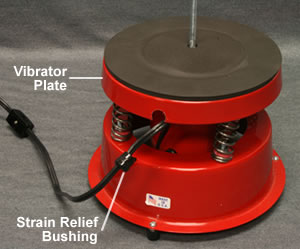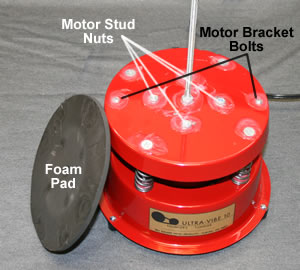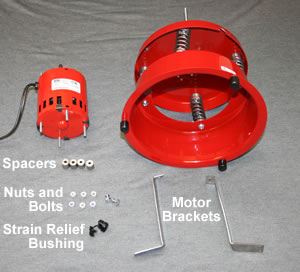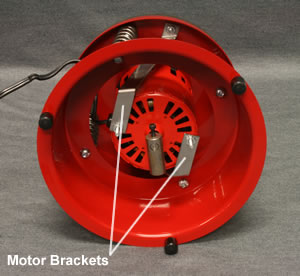Replacing Thumler's UV-10 Vibratory Tumbler Motor

The tools needed to replace the UV-10 motor are a flat head screwdriver, small crescent wrench and vice grips. Along with these tools you will need some silicone.
Before you start
With just a few tools and a little bit of time you can easily replace a worn out motor on a Thumler's UV-10 vibratory tumbler. The tools that you will need are 1) flat head screwdriver, 2) small crescent wrench, 3) vice grips and 4) clear silicone caulk.
Disassembling the tumbler
Safety First
The first step whenever you are working on a piece of equipment is to unplug it. Once the tumbler is unplugged and safe to work with you can start disassembling it.

In this image you can clearly see the strain relief bushing and the slot in the vibrator plate it was in. The black on the vibratory plate is the foam pad that needs removed.
Removing the power cord
Pull the motor wire and strain relief bushing out of the slot on the vibrator plate of the tumbler. This will take some effort and may require using the vice grips to grip the strain relief bushing on the back side of the vibrator plate.
Carefully remove foam pad
The foam pad, on the vibrator plate where the barrel sets, needs to be removed. Remove the foam carefully so you can reuse it after replacing the motor. The pad is stuck to the top with a sticky backing. To remove it just pull lightly and work it off slowly. Removing the foam pad will give you access to the four nuts on the motor studs and the two flat head bolts that secure the motor brackets. If you damage the foam and cannot reuse it you can purchase a new one on our UV-10 parts page.
Remove silicone from around the nuts and bolts
With the foam pad removed you will notice that each nut and bolt is coated and surrounded with clear silicone. The silicone is there to protect the foam pad from any sharp edges that may tear it during operation.
You will need to remove the silicone from around the nuts and bolts that secure the motor and brackets. We used the flat head screwdriver to assist in removing it.

This image show what the top of the vibrator plate looks like with the foam pad removed. It also shows the location of all the nuts and bolts that will need to have the silicone removed.
Undo the nuts and bolts
Once the silicone is removed, undo the nuts and bolts that secure the motor brackets. Now that the motor brackets are disconnected from the vibrator plate, the four nuts that are in the center need to be removed. These nuts are on the motor studs. Be sure to hold the motor when you take off the last nut to ensure the motor doesn't fall.
Pulling out the motor
When you pull the old motor out you will see a spacer on each of the four motor studs. You need to reuse these spacers when you attach the new motor to the tumbler. The motor brackets will still be attached to the bottom of the motor. It is easier to remove these brackets from the bottom of motor now that it is out of the tumbler frame.

Here is all the parts that you should need to put the tumbler back together. Needed are the new motor, spacers, nuts and bolts, motor brackets and the strain relief bushing.
Assembling the Tumbler
Attaching the new motor
Put the spacers on the four motor studs before putting it in place. When putting the new motor in the tumbler make sure that the power cord is coming out where the strain relief bushing slot is cut out of the vibrator plate. This will ensure that the motor brackets line up and the cord won't be touching the motor or be hit by the spinning counter weight, when the tumbler is running.
Tightening up the motor
Once the motor studs are through the vibrator plate, hand tighten the nuts to hold the motor in place. After the nuts are hand tight put the motor mounting brackets in place.

A look at the bottom of the UV-10 tumbler showing the motor brackets placement.
Installing the brackets
Hand tighten the nuts that hold the brackets to bottom of the motor. This allows you to still wiggle the mounting brackets to get the bolt down through the vibrator plate and through the top of the motor brackets. Once the bolts are though the top of the bracket you can then tighten all of the nuts and bolts.
Adding the silicone and foam pad
Before you begin applying the silicone caulk, be sure that all nuts and bolts are properly tightened. This is your last chance to do this before adding the caulk.
Place a generous amount of silicone around all of the nuts and bolt heads that are on top of the vibrator plate. Allow the silicone ample time to dry.
Once the silicone is dry it is time to put the foam pad back on the vibrator plate. Do your best to make sure the threaded rod that holds the bowl down is centered in the hole of the foam pad. If the pad isn't centered on the vibrator plate the bowl may not set level when you tighten it down.
Inserting the wire strain relief bushing
Now on to the last step, the one I felt was the most difficult, placing the power cord in the strain relief bushing and getting it back into the slot on the vibrator plate of the tumbler. Here is where the pliers come into play. Place the strain relief bushing over the power cord, approximately five inches from the motor. That distance allows a little slack between the motor and the wire guard so there isn't much strain on the cord where it attaches to the motor. Once it is in the proper place on the cord squeeze it tightly with the pliers. One side of the pliers should be on each of the two pieces and near the back of the relief bushing. This allows you to squeeze the protector enough so you can wiggle and force it into place. Make sure that the strain relief bushing is in a position that will not allow it to open during operation.
Congratulations! You are now ready to get back to tumbling.
RockTumbler.com Authors
 |
Hobart M. King has decades of rock tumbling experience and writes most of the articles on RockTumbler.com. He has a PhD in geology and is a GIA graduate gemologist. He also writes the articles about rocks, minerals and gems on Geology.com. |

